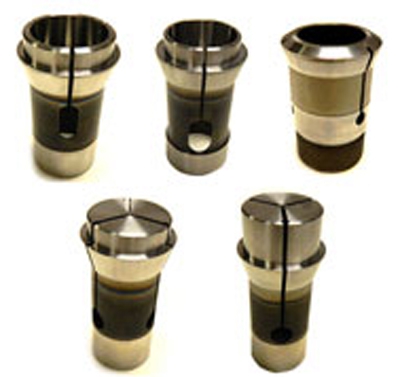
Hardinge announces the release of several new Swiss collets which will be sold as standard items. Working with Tsugami, the company introduced the TF43, STM38, and BS38 Swiss collets.
"This extension of our Swiss collet product line gives us the opportunity to continue to grow our Swiss offering," states Rick Schonher Productions Manager for Workholding.
The new TF43 Headstock collets are machined to precise size and TIR to meet the precision machining requirements.
Another new product is the STM38 guide bushing. Hardinge's guide bushings are carbide lined to keep the stock clean and unmarked. Hardened steel or Meehanite-lined bushings can be made for certain stock that is not compatible with carbide.
The BS38 Pickoff collets are available as standard length or extended nose. Extended nose collets may be straight out or tapered to compensate for tooling interference.
TF37SP is now offered in the emergency and extended nose emergency styles. An emergency collet may be used when a standard collet is not readily available. These collets can be machined to the desired bore size and used until a hardened collet is available. The TF37SP extended-nose emergency collets feature added length. This is necessary when performing pickoff work and also to compensate for tooling interference.
"We carry a large collet inventory for most brands of Swiss-style CNC lathes and cam-operated lathes. We provide same-day shipping and have an experienced sales and engineering staff to support our customers," continued Schonher.
Contact Details
Related Glossary Terms
- bushing
bushing
Cylindrical sleeve, typically made from high-grade tool steel, inserted into a jig fixture to guide cutting tools. There are three main types: renewable, used in liners that in turn are installed in the jig; press-fit, installed directly in the jig for short production runs; and liner (or master), installed permanently in a jig to receive renewable bushing.
- collet
collet
Flexible-sided device that secures a tool or workpiece. Similar in function to a chuck, but can accommodate only a narrow size range. Typically provides greater gripping force and precision than a chuck. See chuck.
- computer numerical control ( CNC)
computer numerical control ( CNC)
Microprocessor-based controller dedicated to a machine tool that permits the creation or modification of parts. Programmed numerical control activates the machine’s servos and spindle drives and controls the various machining operations. See DNC, direct numerical control; NC, numerical control.
- precision machining ( precision measurement)
precision machining ( precision measurement)
Machining and measuring to exacting standards. Four basic considerations are: dimensions, or geometrical characteristics such as lengths, angles and diameters of which the sizes are numerically specified; limits, or the maximum and minimum sizes permissible for a specified dimension; tolerances, or the total permissible variations in size; and allowances, or the prescribed differences in dimensions between mating parts.
- total indicator runout ( TIR)
total indicator runout ( TIR)
Combined variations of all dimensions of a workpiece, measured with an indicator, determined by rotating the part 360°.









